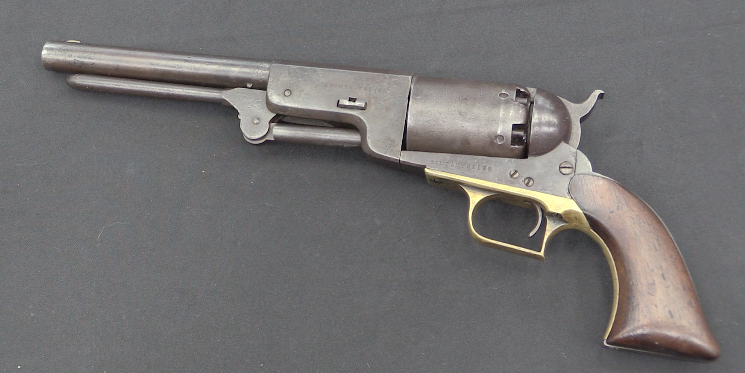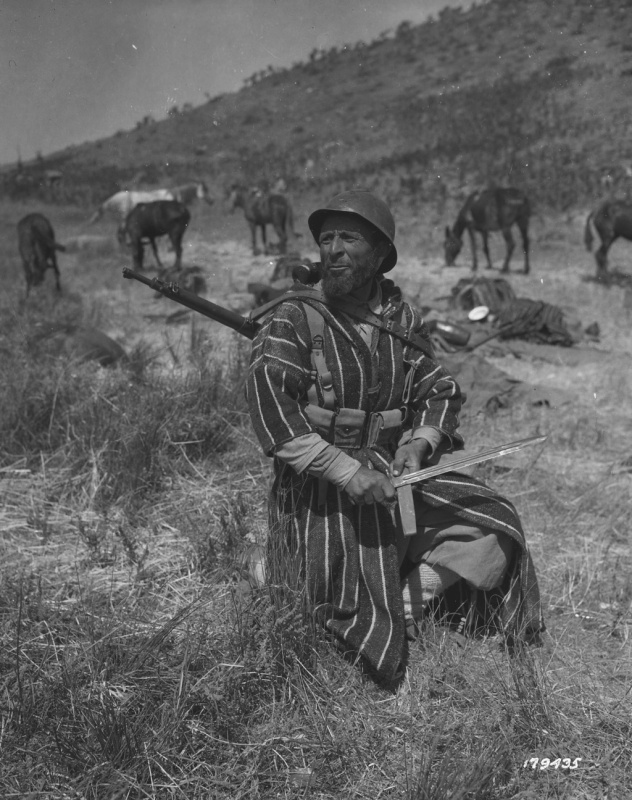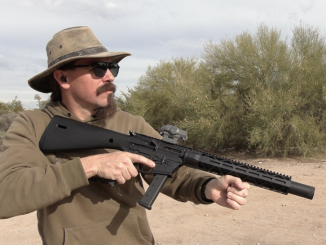Made by SSK Industries on a McMillan action, the .950 JDJ is the largest sporting rifle made. The cartridge began as a 20mm Vulcan round, cut down to 70mm case length and necked up to 24mm (.95 caliber). It required a special sporting purposes exemption form the ATF to not be classified as a destructive device under the NFA. It’s a pretty huge rifle with a pretty huge muzzle brake and pretty huge recoil!
Related Articles

Percussion
1847 Walker Revolver at RIA

Bolt Action Rifles


Yikes! A brick wall wouldn’t offer any ballistic protection from this!
A brick wall won’t stop a .50 BMG round, either.
The .950 JDJ fires an 8-ounce (3,500 grain) bullet at 2,300 F/S. This works out to 41,122 foot-pounds of muzzle energy. By comparison, a .50 BMG with the 700-gr. NATO bullet at 2,800 is “only” good for 12,120.
Exactly what you’d need that to kill is a pretty good question. An even better one is how many times you can fire it in quick succession before you break your shoulder.
cheers
eon
What would I kill with this rifle? How about a mad car bomber?
Gophers.
Armadilos.
*llos*
“An even better one is how many times you can fire it in quick succession before you break your shoulder.”
Then I would suggest, that Pansarvärnsgevär fm/42
http://modernfirearms.net/atr/swed/carl-gustav-m42-e.html
as more practical for such application, recoil problem solved, there is backblast which might give your position, but muzzle brake also do it.
Hollowood has taught people that even tabletops can stop bullets… In reality civilian housing structures provide a very poor protection against bullets. 12.7mm heavy machine gun bullets will go through basically any wall of typical civilian houses and apartment buildings with enough energy to kill people behind them. Even full power 7.62mm “ball” (soft core FMJ) will go through many exterior walls. AP of course is much more effective. Interior partition walls provide virtually no protection against bullets. They provide only concealment but no cover to speak of.
If civilian house has to be used for defense, the first order of business is to reinforce the walls by sand bags, or if you have them, steel plates.
The head of Wagner Group and other heavily protected despots around the world with a dead center shot?
When that Indominus Rex comes charging at you you will so regret not having bid on this when you had the chance.
Yes, but like… how does it perform in Ballistic Gell?
What was the sporting purpose that got it exempt from the NFA? Shooting down Russian satellites lol.
Was that 4 Bore rifle not “larger”? ^__^
And then there’s the 2 Bore…
Due to their age, and the fact that they were designed and built for black powder ammunition, the old “elephant guns” for heavy African game are classified as “Curios and Relics” under NFA.
However, if you tried to build a new one today, chambering a round using modern smokeless propellant, you would need to petition for an exemption from NFA, as with the .950 JDJ, to avoid it being classified as “any other destructive device”. Which BTW includes things like artillery pieces.
cheers
eon
You mean this thing isn’t an artillery piece?
Technically it’s not artillery in the way it’s used. Sure, the projectile is huge, but the weapon itself was designed for civilian usage, so classifying the rifle as a small infantry support weapon would not be a good idea unless you’re going to stick it on a wheeled carriage mount complete with elevation and traverse gearing. And even that would be unnecessary because the manufacturer doesn’t want to give you ammunition with explosives packed in the projectile (yet another legal issue).
“You mean this thing isn’t an artillery piece?”
Depend on taxonomy, from Russian point of view 20 mm and above is cannon, from Imperial-Russian (as used during First World War) point of view 25,4 mm is minimum to be cannon, from WWII German point of view 30 mm is minimum for cannon
There are 2- and 4-bores currently available from a UK maker. See recent issue of Firearms News.
“Was that 4 Bore rifle not “larger”?”
Wait, I know about 4 Bore Shotgun (smooth bore), but not rifle (rifled), what is your source of information of such weapon? When it was made?
Here is an FW link: https://www.forgottenweapons.com/james-d-julia-an-overview-of-4-bore-stopping-rifles/
Daweo,
No need to limit yourself to the punny 4 Bore:
https://www.youtube.com/watch?v=eXoa5zNn0TU
How about a 2 Bore rifle? ^__^
and now a few shots offhand ……
Why to limit yourself to only to 24 mm gun? Why not get that 30 mm
https://raigap.livejournal.com/86348.html
Maadi Griffin 30mm chambered for 30×173 mm (cartridge used in Oerlikon KCA revolver cannon)
Or 35 mm
http://raigap.livejournal.com/95319.html
Swiss ARPAD 600, cartridge 35×176, 167 g bullet @ 650 m/s, overall mass 7,5 kg, overall length 960 mm, barrel length 805 mm, single-shot, sights scaled to 600 m, armor piercing: 50 mm @ 600 m, perpendicular hit
ARPAD didn’t fire the 35×176 cartridge – in fact I can’t even find a reference to such a cartridge existing. The 35mm Oerlikon round is 35 x 228 although they do a 30 x 173.
Anyway, ARPAD fired a unique round with a HEAT projectile with the entire round looking like a miniature artillery shell fitted into a very short case. It is unlike a 40mm grenade as it has a long, tapering ogive. Page 458 of Janes Infantry Weapons 1987-88, if you happen to have a copy lying around . . .;-)
Tony Williams lists such a round, but country of origin is listed as USA and weapon as “AMRON experimental”:
http://www.quarryhs.co.uk/ammotable5.html
Sorry, actually it is 30×173, not 30×176. So I can’t find such a round either.
If Mr Williams doesn’t list it then it can’t exist!
Those are definitely “handheld cannons” rather than rifles. They even have recoil systems like modern artillery pieces.
An 8 oz projectile? You could throw it and do serious damage. It would have been nice to see the cartridge.
“It would have been nice to see the cartridge.”
http://www.ammoandguncollector.com/2013/08/950-jdj-worlds-largest-sporting-bullet.html
compared to .22 Hornet, .30-30 Winchester, .500 NE and .50 BMG
Pic’s of the cartridge here: https://www.rockislandauction.com/blog/shooting-fat-mac-the-950-jdj-rifle/
Does this qual;ify as gun porn?
just imagine the holster it would need!
“It’s a pretty huge rifle with a pretty huge muzzle brake”
This reminded me about so-called Vickers-Crayford rocket gun
https://en.wikipedia.org/wiki/1.59-inch_Breech-Loading_Vickers_Q.F._Gun,_Mk_II
Note the long eye relief scope in the “Scout Rifle” position. I’m guessing this is to prevent the worst case of “Kaibab eye” in history.
cheers
eon
One of Russian black-powder era gun of similar caliber – 20,4 mm – namely Ружье крепостное Крнка-Гана обр. 1876 г. see photos here:
http://www.museum-arms.ru/collections/detail.php?ELEMENT_ID=6587
has special big hook to deal with recoil
Wow what a cloud of smoke blowing out of the muzzle. Looks like it uses diesel fuel or coal for propellant.
Yes; it reminds me of artillery pieces with muzzle brakes.
“artillery pieces with muzzle brakes”
In case of field cannons, visual effect is not only powder gases, but also dirt, thus size depends also on type of ground. Muzzle brake was tested on F-22 cannon prototype, but as it was considering to make too big cloud (showing position to enemy), it was not used in serial produced F-22 and subsequent field cannon of that same caliber – USV, encountering German guns which used muzzle brake leaded to change and in effect ZiS-3 and others Soviet field cannon designed during Great Patriotic War and later have muzzle brakes.
showed the power of powder gases, and the topic was not disclosed